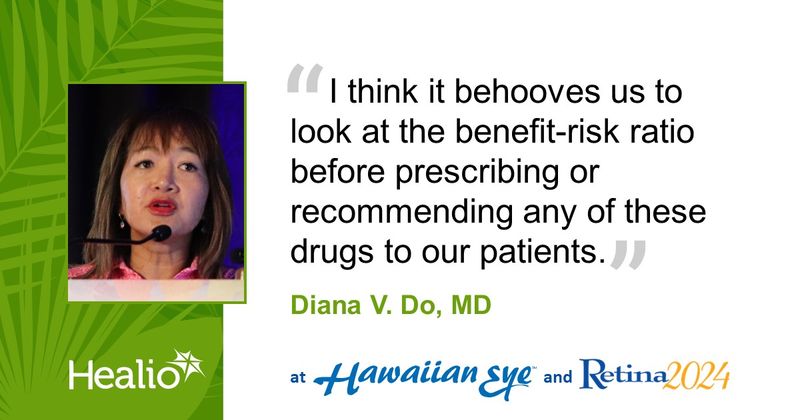Clinicians must weigh risks of geographic atrophy medications
Click Here to Manage Email Alerts
WAILEA, Hawaii — Clinicians need to balance the efficacy of geographic atrophy medications with the risks, according to a speaker at Retina 2024.
Diana V. Do, MD, said retina specialists take several factors into account when selecting a medication for their patients.

“We look at efficacy, safety and other challenges, such as cost and treatment burden, before deciding on the optimal therapy,” she said. “With the advent of two new FDA-approved therapies for geographic atrophy, it’s more important than ever to take into account all these factors when deciding on a medication for our patient.”
Syfovre (pegcetacoplan injection, Apellis Pharmaceuticals) was the first treatment approved for geographic atrophy. In the OAKS and DERBY trials, Do said patients in the pegcetacoplan treatment arm had higher rates of choroidal neovascularization, ischemic optic neuropathy, intraocular inflammation and endophthalmitis compared with the sham pooled arm.
As of Oct. 12, 2023, there have been 14 confirmed cases of retinal vasculitis that occurred after the first injection of pegcetacoplan. The incidence of retinal vasculitis is still unclear because cases may be underreported and it is difficult to estimate the number of medication vials that have been used. Possible mechanisms include immune response, intraocular infection and complement inhibition.
“We do not know yet, and that is why it is difficult to determine who might be at risk for this rare but very serious adverse event,” she said.
The second FDA-approved geographic atrophy drug Do discussed was Izervay (avacincaptad pegol intravitreal solution, Iveric Bio). In the GATHER1 and GATHER2 trials, patients in the treatment arm had higher rates of choroidal neovascularization compared with sham. However, the GATHER trials had a smaller number of patients and were not powered to detect rare safety events, and real-world data will help inform clinicians on the drug’s safety profile. She said that there has been one case of bilateral retinal vasculitis and associated occlusive vasculopathy after the patient received pegcetacoplan in one eye and avacincaptad pegol in the other eye 4 days later.
“That’s why as clinicians and retina specialists, it’s very important that if we do encounter any of these rare side effects in our clinical patients, we should report this to both the company and the American Society of Retina Specialists to warn other clinicians about these safety signals,” Do said. “I think it behooves us to look at the benefit-risk ratio before prescribing or recommending any of these drugs to our patients.”

